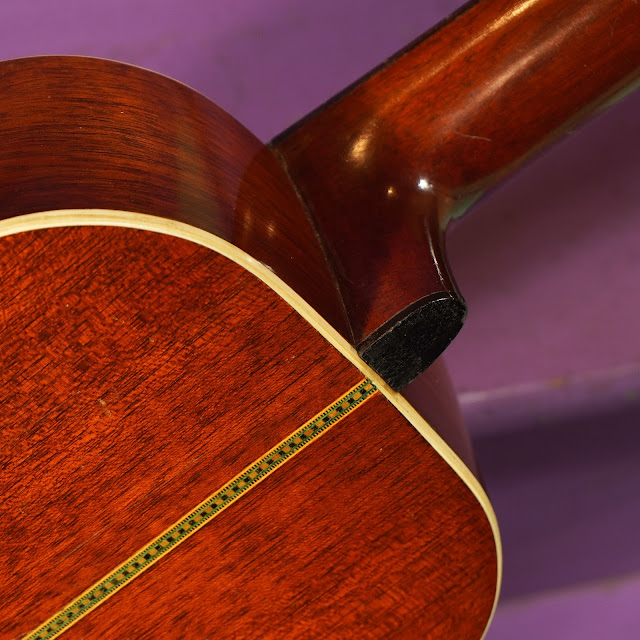1900s Unmarked (Possibly Bauer) Gut-Strung Parlor Guitar
A customer of mine sent this lovely little box in some time ago. It arrived crack-free but needing some work to get it back up to snuff.
I'm pretty sure that this was made by Bauer around 1900-1910 but it's unmarked. It has a ton of Bauer-like features, though, like the thin and narrow heel, body shape, shallow tenon joint, neck profile and headstock shape, fretboard style, and bridge cut. The Gibson-ish 24 7/8" scale is similar to other Bauers I've worked-on, too, and unusual for most other makes at the time. There are discrepancies, however, but I haven't handled any two Bauer-make instruments that are identical and most have been fancier models than one like this. I think that, if it's not a Bauer-made instrument, then it's likely made by someone who worked for the firm or worked for Bay State/Haynes, as it shares some features with those, too.
At any rate this would have been an upper-mid-grade instrument for the time, as it's solid spruce over solid mahogany, roughly "Size 2" in dimensions, and has some nice upgrades by way of a rosewood pyramid bridge, fancy colored purfling and trim, and good attention to detail in the build. It's braced very light and would fail horribly if ever strung with steel. When it was made it was certainly intended for gut (modern: nylon/classical) strings and I've set it up for light-tension nylons at the moment. The top has one ladder brace above the soundhole, one below, and a wide/flat bridge plate brace. There's no other bracing on the top -- it's basically braced like an oversize ukulele -- and as a result the sound is full, snappy, warm, and loud for its size.
It's also mostly original but I have modified the bridge stringing style a bit and fit a new saddle. It plays perfectly and is ready to go.
Repairs included: neck reset (with two hidden bolts added for durability -- it has a shallow tenon joint, not a dovetail), fret level/dress and seating, side dots install, bridge modification (to "string-through" -- you slip the string through the drilled hole, pull it up and out the soundhole, knot it into a ball, and then pull it back snug under the top and up to the headstock), minor seam repairs, and setup.
Top wood: solid spruce
Back & sides wood: solid mahogany
Bracing type: ladder
Bridge: rosewood
Fretboard: ebonized something-or-other
Neck wood: mahogany
Action height at 12th fret: 3/32” overall (quick)
String gauges: light-tension nylon
Neck shape: medium-bigger C/soft V
Board radius: flat
Neck relief: straight
Fret style: low/smaller
Scale length: 24 7/8"
Nut width: 1 3/4"
Body width: 12 1/2"
Body depth: 3 1/2"
Weight: 2 lbs 9 oz
Condition notes: it's quite clean and crack-free except for the fretboard which has a number of minor hairline dryness cracks which are glued/filled and pose no issue save looks. The fretboard extension also dips down over the body, so if you play past the 12th fret a lot you may want to consider that. The modified bridge has an extra-tall saddle but the back-angle on the saddle is not extreme so it may look a little odd but it won't hurt the guitar. I was trying to get a modern classical-height feel without changing the bridge. Experiments! Otherwise the guitar is original throughout save the mounting-screws for the tuners. There are small surface scratches, nicks, and dings here and there but overall it's a very clean guitar. Oh! But the back of the headstock does have a mid-size chipout on one corner of the top.
It comes with: its original hard case in great shape. How about that?
























Comments